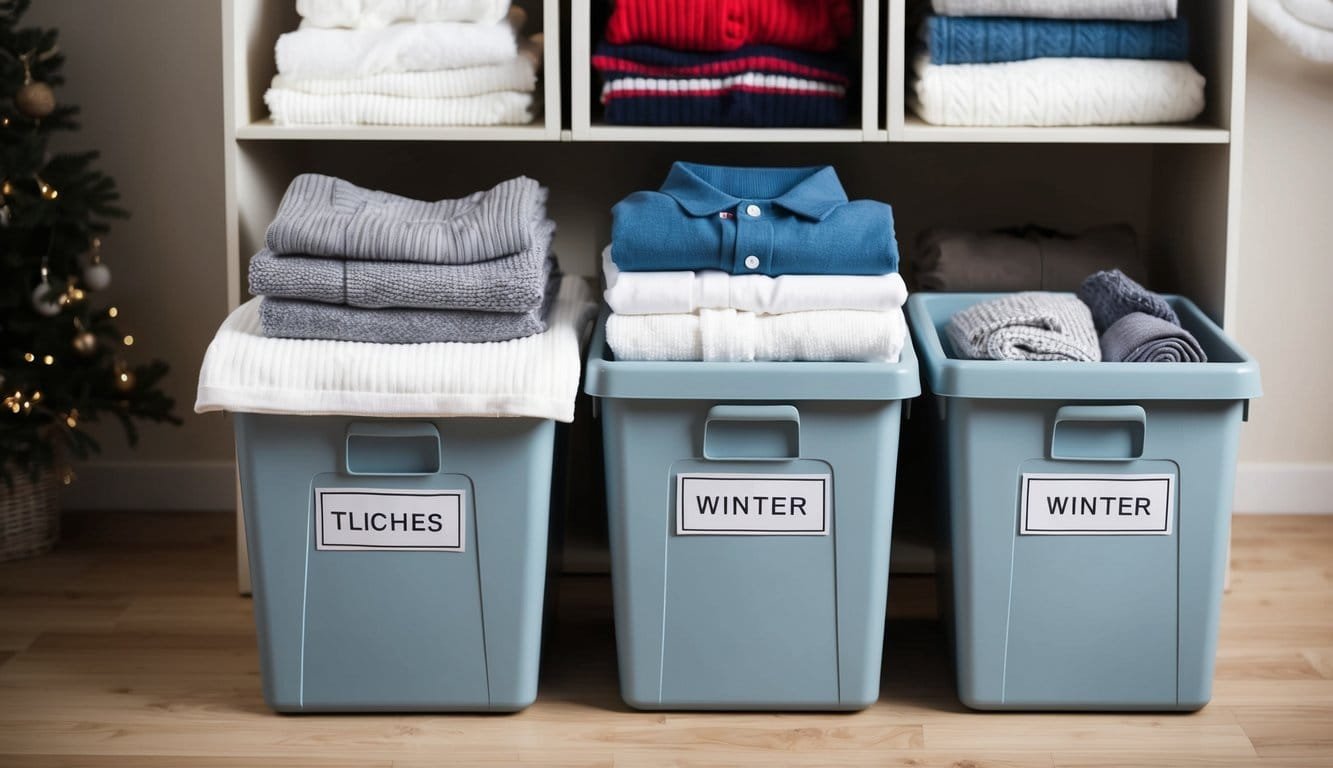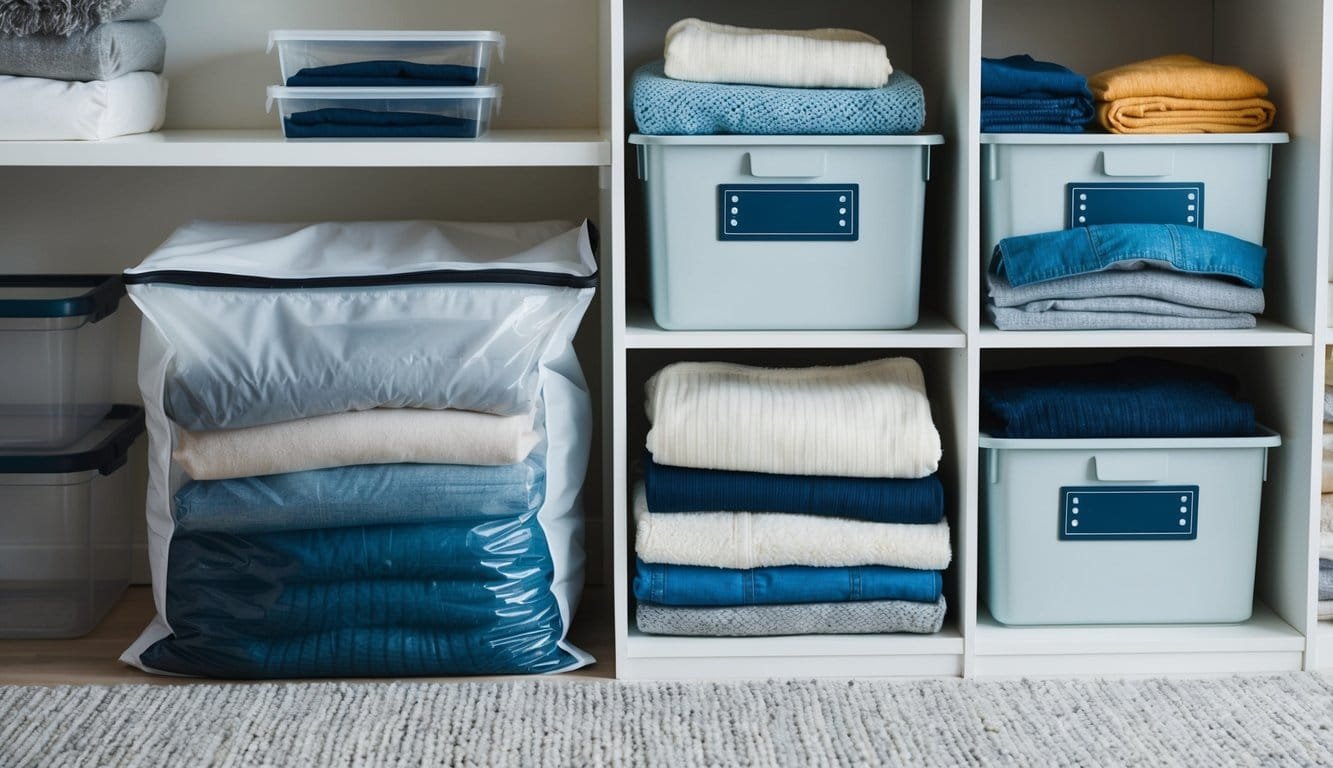Storing winter clothes properly is a game-changer when it comes to keeping them in great shape for years to come. As the seasons change and you’re swapping out coats for T-shirts, you might be wondering just how to organize everything so it’s ready next time you need it. With a few straightforward steps, you can make the most of your storage space and ensure your clothes stay fresh and ready for winter’s return.
To organize winter clothes for storage, start by cleaning each item and making any necessary repairs. Group similar types of clothing together, use vacuum-sealed bags or plastic bins for compact storage, and find a cool, dry place to keep them safe from moisture and pests.
Throughout this article, you’ll find tips on maximizing storage space, such as using under-bed bins and rotating your closet layout. There will be a guide on organizing clothes by type and suggestions for maintaining quality while in storage.
- Understanding Your Storage Needs
- Preparing Clothes for Storage
- Selecting Appropriate Containers
- Packing Tips and Tricks
- Keeping Clothes Fresh and Protected
- Labeling for Ease of Access
- Utilizing Off-Season Storage
- Organizing Accessories and Gear
- Streamlining Your Winter Wear for Next Season
- Maximizing Storage Techniques
- Frequently Asked Questions
Understanding Your Storage Needs
Figuring out how to store winter clothes starts with knowing your needs. It’s important to evaluate your available space and select solutions that use every inch effectively.
Evaluating Closet Space
Begin by examining your closet. Take note of how much space is already in use. Organizing by category, like coats and sweaters, can help you see what space you have to work with. This not only tidies up things but also helps with finding clothes later.
Use vertical space: Install extra shelves or rods to maximize closet space. Hanging organizers or over-the-door solutions can hold smaller items like hats and scarves. These tools help utilize every bit of your closet efficiently.
Consider under-bed storage: If your closet space is tight, consider storing clothes under the bed or in bins. This storage style is great for items that won’t be used frequently, like heavy coats. The most important part is knowing how to use your available storage areas smartly. Organized clothes take up less space and are easier to retrieve.
Choosing Storage Solutions
Choosing the right storage solutions makes a big difference. Start by picking the materials wisely. Use breathable materials, like cotton, to protect clothes. Plastic bins are good for short-term storage but not the best for longer periods.
Invest in quality bins: Sturdy bins or boxes with lids protect clothing from dust. Label them to make reaching for that favorite sweater next winter easier. You can even use vacuum-sealed bags to save space and keep items safe from moisture and pests.
Use space-saving options: If you lack closet space, try vertical storage solutions, such as tall shelves or stackable boxes. Over-the-door organizers are also a clever way to store accessories without taking up too much room. Efficient solutions can make winter clothing storage stress-free!
Preparing Clothes for Storage
Getting your winter wardrobe ready for storage involves a couple of important steps to ensure your clothes stay fresh and in good condition. Start by cleaning everything properly, then sort your items to keep them organized and protected.
Cleaning Winter Apparel
Before tucking away those cozy sweaters and jackets, make sure all winter clothes are clean. Stains can set in over time, and even tiny bits of food can attract pests. Wash or dry clean your clothes according to the care labels. Tip: Use a gentle detergent to maintain fabric integrity.
For knitted items, consider hand washing them yourself. Hang or lay garments flat to dry instead of using the dryer to prevent shrinkage. Once everything is clean, fold clothes neatly to avoid wrinkles. Use acid-free tissue paper between layers to help prevent any unwanted creases.
Sorting Winter Wardrobe
Once clean, it’s time to sort your winter wardrobe. Divide clothes by type, such as sweaters, coats, and accessories. Doing this will make retrieving specific items easier. List of Categories:
- Coats and Jackets
- Sweaters and Cardigans
- Scarves, Hats, and Gloves
Keep items you use more frequently in easily accessible places. Store less frequently used clothing, like formal wear, further back. Use clear plastic bins or canvas storage bags to keep everything organized. Adding labels or photos of the contents to the outside helps you find what you need quickly.
Selecting Appropriate Containers
Choosing the right type of container is important for keeping winter clothes looking their best. It can help prevent damage from moisture, pests, or dust. Let’s explore different options like bins, bags, and vacuum sealing to see which might work best.
Bins vs. Bags
Storage bins and garment bags are two main options for storing clothes. Plastic storage bins are great for keeping out moisture and pests. Sturdy and stackable, these plastic containers store well in attics or basements. They’re ideal for bulkier items like coats and sweaters.
On the other hand, garment bags, often made of breathable fabric, are perfect for hanging items. They allow clothes to stay aired out, which is great for wool or delicate materials. Yet, they don’t stack, taking up more space. People might prefer these for formal clothes that need to maintain their shape.
The Magic of Vacuum Sealing
Using vacuum-sealed bags is like a superpower for organizing clothes. These bags compress the clothing, saving tons of space. They’re particularly useful for items that aren’t worn frequently, as they can be stored under the bed or in tight closet spaces. Vacuum bags not only save space but also protect from dust and moisture.
Packing different types of clothes in separate bags makes it easy to grab what’s needed when seasons change. However, items like leather or knit might lose shape if compressed too long. Always check the garment’s care instructions before sealing. Ensure the vacuum bags are properly sealed to keep contents fresh and clean.
Packing Tips and Tricks
Packing winter clothes for storage can seem daunting, but with a little know-how, it can be a breeze. By using smart layering and effective folding strategies, those bulky winter clothes can fit neatly away for the season.
Layering Items Strategically
When storing winter clothes, it’s helpful to layer them in a way that maximizes space and minimizes wrinkles. Start with the heaviest items, like coats and jackets, at the bottom of your storage box or bag. These bulky pieces form a sturdy base. Next, add lighter items like sweaters and cardigans.
Rolling lighter garments can help maximize space. Use a piece of tissue paper between layers to prevent fabric from creasing. If you’re storing clothing in a drawer or smaller box, stack items vertically, like files in a drawer, to access them easily. Remember to keep similar items together and tightly pack them to reduce movement during storage.
Optimizing Space with Folding Techniques
Using the right folding technique makes a big difference in how much you can store without wrestling with your closet later. The KonMari method, where clothes are folded into small rectangles and stood upright, is useful for saving space. Bulky sweaters and jackets can be folded to maintain their shape and keep neat.
- Coats and Jackets: Lay flat, fold sleeves in, and fold in half.
- Sweaters: Lay flat, fold sleeves over, and then in half.
- Scarves and Beanies: Roll them up tightly.
Wrap delicate clothing such as wool or silk in acid-free paper before packing. When folding isn’t suitable, use vacuum storage bags for even more space optimization. They compress the clothes and seal out moisture.
Keeping Clothes Fresh and Protected
Storing winter clothes properly can prevent damage and keep them ready for the next cold season. Key strategies include managing moisture and pests using natural solutions.
Combating Moisture and Humidity
Moisture is a big enemy when storing clothes. It leads to musty odors and even mold. Dehumidifiers can help maintain the right humidity level in storage areas. Aim for a relative humidity of around 50%.
Tips to prevent moisture issues include:
- Use silica gel packs: These are handy for absorbing moisture.
- Activated charcoal: Great for reducing moisture and odors.
- Air-tight storage bins: These can further protect clothes from humidity.
Ensuring airflow where you store clothes also helps. Even if covered, a little ventilation can keep garments fresh and avoid that stale smell.
Deterring Pests Naturally
Protect winter clothes from pests that love to munch on them. Cedar blocks and lavender sachets are natural deterrents. Cedar is especially good for keeping moths away while adding a pleasant smell.
Other natural options:
- Dried orange peels: Work well and smell good.
- Clove sachets: Another aromatic pest repellent.
- Freezing garments: A quick way to kill off any existing pests.
Natural options are safer and healthier, helping keep your clothes in top condition without strong chemicals. Always check on stored items now and then to catch any pest issues early.
Labeling for Ease of Access

Organizing your winter clothes can be straightforward if you have a good labeling system. Knowing where everything is makes it easier to find what you need when seasons change. Using boxes or bins, clearly and creatively labeled, ensures accessible and clutter-free storage.
Creating a Labeling System
A labeling system guides you when storing clothing. Start by sorting items into categories like sweaters, coats, and accessories. Use sturdy, waterproof labels for durability. Consider using color-coded labels for different types of clothing. This visual cue can speed up retrieval.
List key details on each label, such as the clothing type and size range. Handwritten or printed labels work, though printed labels often look neater. Try using large font sizes for easy reading. Digital labeling, like QR codes, can be helpful. Create a corresponding list on your phone or computer for extra reference.
Implementing Seasonal Rotation
Seasonal storage requires rotating items efficiently. Use separate bins for each season and label everything clearly. For instance, having bins marked “Winter Coats” or “Spring Dresses” keeps closets organized. Place the labels on the front of the bins, where they’re easy to see.
Label bins with the current date when packed. This helps track when items were stored and reminds you to check for wear over time. Create a system for quick swapping between seasons, making sure winter items are easy to access before cold weather hits. With clear labels, seasonal transitions become smooth and manageable.
Utilizing Off-Season Storage

Storing winter clothes properly can help save space and keep items in good condition. Let’s explore how using storage solutions can make managing seasonal items easy and efficient.
Exploring Off-Site Options
Using off-site storage is a great way to free up space at home. This option is especially useful for those with limited closet space. Many storage companies offer climate-controlled units, which help protect wool sweaters and other delicate items from humidity and pests.
When selecting a storage facility, consider the location, cost, and security features. Some places allow on-demand delivery of items straight to your home. This means your winter coats could be just a quick call away whenever you need them. If you’re on a budget, sharing a unit with a friend or family member could also be a viable option.
Reclaiming Hidden Storage Areas
Reclaiming space at home for your seasonal items is possible by looking beyond typical storage spots. Under-bed storage containers are perfect for storing winter boots and jackets when they’re not in use. An attic or basement can also serve as an excellent place to stash larger items.
Using under-bed options ensures that the space under furniture is not wasted. Consider using vacuum-sealed bags to shrink winter items down to a manageable size. This not only saves space but keeps dust and moisture at bay. Ceiling-mounted racks in garages or utility rooms can also hold bins for off-season items, freeing up floor space.
Organizing Accessories and Gear
Keeping winter gear organized can save time and prevent frustration when cold days arrive. Focus on sorting items like scarves, hats, and gloves, while also finding storage solutions for bulkier gear such as snow boots and coats.
Sorting Winter Accessories
Winter accessories, like scarves and gloves, can easily get lost in the shuffle. Start by grouping similar items together. Gloves, for instance, can be paired up and placed in a small box or basket. Hooks or small bins work well for hanging or storing scarves and hats.
Labeling is key for easy access. Use clear storage bins with labels for quick identification. A hanging organizer on the back of a door is another smart way to keep track of these smaller items. If you’re inclined to get crafty, consider making a custom accessory board with hooks and clips to display and organize everything neatly.
Storing Bulkier Winter Gear
Bulkier items, such as coats and snow boots, need a different approach. Coats should be hung up in a closet with sturdy hangers. Arrange them by size and type if space allows. Use vacuum-sealed bags for extra jackets to save space.
For snow boots, use a shoe rack or waterproof mat to keep things tidy. Consider placing a boot tray by the entrance to manage the mud and snow. For easy retrieval, store these items where they are most convenient, like a mudroom or entryway closet. Keep these solutions in mind to maintain a clutter-free storage area for all winter apparel.
Streamlining Your Winter Wear for Next Season

Preparing your winter clothes for storage can save time and space next year. Giving away extra items and refreshing your wardrobe ensures you only keep what you love.
Donating and Selling Tips
Before storing winter clothes, go through your wardrobe to decide what to keep, donate, or sell. If items don’t fit or haven’t been worn in a year, consider donating them to a local charity or thrift store. For pricier items in good condition, you might want to try selling them at a consignment shop.
To make the process simple:
- Create three piles: keep, donate, sell.
- Use apps like Poshmark or ThredUp for online selling.
- Ensure items are clean before donating or selling to make them more appealing.
Remember, less clutter means easier storage and quicker prep for the next cold season.
Seasonal Refresh Strategies
Refreshing your winter wardrobe before storing can help keep your clothes fresh. Start by washing and drying all winter garments. This prevents any stains from setting in and deters pests. Use lavender or cedar sachets to keep your clothes smelling nice and protect them from moths.
Here are some quick tips:
- Inspect for damages like missing buttons or small tears, and fix them right away.
- Store in airtight containers or vacuum-sealed bags to protect against moisture.
- Label storage bins for easy access next year.
These small steps make unpacking next season a breeze, ensuring your clothes are ready to wear as soon as they come out of storage.
Maximizing Storage Techniques
When it’s time to store away winter clothes, finding the right techniques can save space and keep everything in top condition. Using tools like shelf dividers can help organize your space, while deciding whether to hang or fold garments ensures they stay in the best shape.
Implementing Shelf Dividers
Shelf dividers are terrific for keeping your storage neat and organized. They create separate sections on the same shelf, making it easy to categorize and store different items like sweaters, pants, and scarves. This prevents clothes from toppling over and mixing up.
Here’s how to use them most effectively:
- Material Choice: Choose dividers made of acrylic or metal for durability.
- Placement: Keep similar items together; for example, all sweaters in one section.
- Size Matters: Measure your shelves to ensure a snug fit without slipping.
These simple tools can transform any cluttered shelf into an organized haven.
Hanging vs. Folding Garments
Deciding between hanging and folding is crucial for maintaining clothing shape. Hanging is ideal for coats and jackets that need to retain their structure. Use padded hangers to avoid shoulder bumps.
Folding is best suited for items like knit sweaters which can stretch out if hung. Use tidy stacks to prevent wrinkles. Lay garments in drawers or on shelves with sufficient support to maintain shape.
Key Steps:
- Hang items to avoid creases.
- Fold knitwear to prevent stretching.
- Ensure proper spacing to avoid overcrowding.
Making the right choice between hanging and folding can extend the life of your clothes and help them look their best throughout the seasons.
Frequently Asked Questions
Organizing winter clothes for storage might seem tricky, but it’s totally doable with a few smart tips. From utilizing tiny closets to combatting humidity, these answers will guide you through the process with ease.
What’s the secret to squeezing all my winter outfits into a tiny closet?
Maximize space by using slim hangers and vacuum-sealed bags for bulky items.
Consider stacking vertically by adding shelves or using space-saving organizers. Hanging items like scarves or belts on the back of the door can also free up extra space.
Any tips on how a DIY queen or king can craft the ultimate winter wardrobe storage?
Try repurposing old boxes or crates with a fresh coat of paint to turn them into chic storage bins. Label everything to make it easy to find your favorite sweater without making a mess.
Cedar balls or lavender sachets are great to keep things fresh.
Can I get a drumroll for the most magical containers that keep the sweater fuzz at bay?
Plastic bins with tight-fitting lids are perfect for keeping dust and moths away. Look for ones with clear sides so you can easily spot your items without opening every box.
Cotton storage bags are also a good option as they allow fabrics to breathe.
Ever tried vacuum-sealing your parka? Give me the scoop on squishing down my puffy jackets!
Vacuum-sealing is a game-changer for bulky clothes like parkas. It saves space and protects items from dust. Just make sure they’re completely dry before sealing to prevent mold.
Keep a small section open to let some air exchange for longer-term storage.
Humidity’s got a vendetta against my woolens—how do I win this battle in the closet?
Use silica gel packets or moisture absorbers in your storage containers to keep woolens dry.
Consider a dehumidifier in particularly damp areas. Always ensure clothes are clean and dry before storing them to avoid moths and mildew.
How do I Marie Kondo my avalanche of winter wear without turning into a cold-hearted fashionista?
Start by pulling everything out and sorting into keep, donate, and toss piles.
Ask yourself if each item sparks joy, channeling your inner Marie Kondo.
Consider seasonal swaps and rotating clothes between warm and cold weather to save space.







